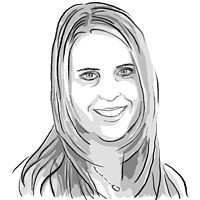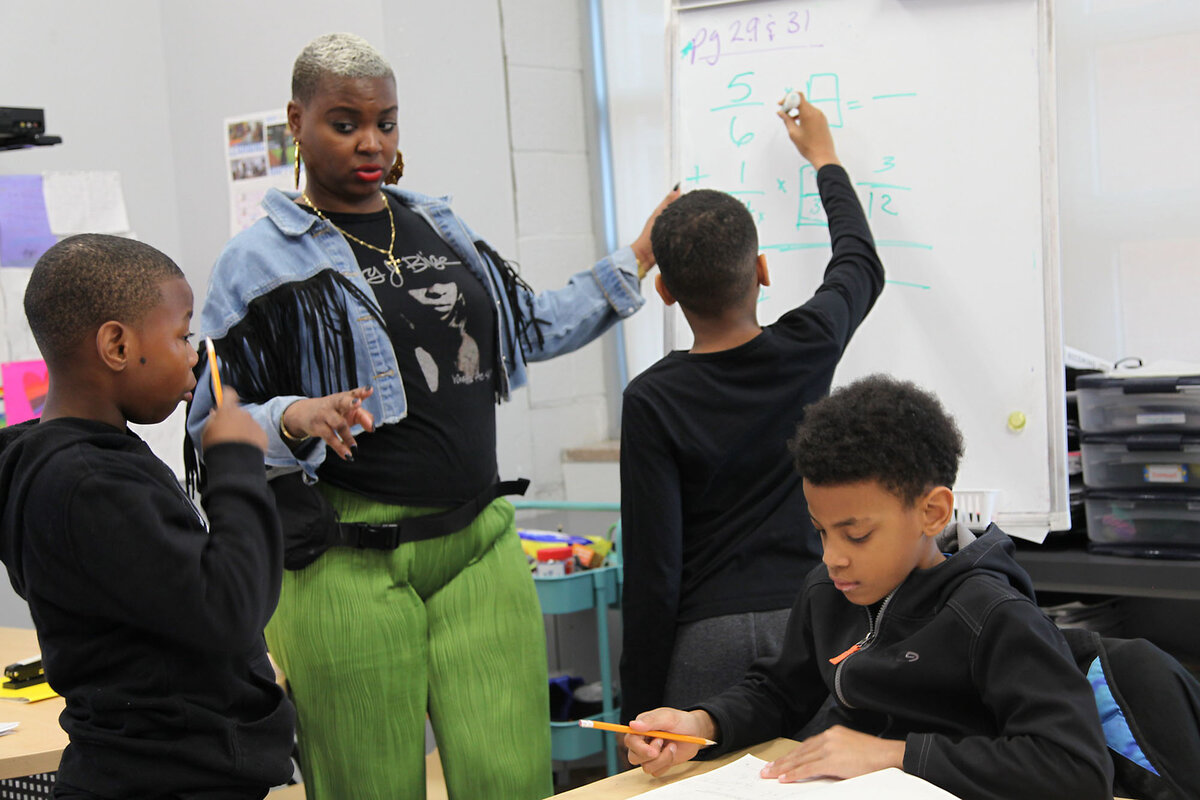Tutoring is getting kids excited about school. Educators want to make it permanent.
Loading...
Education disruptions during the pandemic triggered a scramble to help students in the United States. Many school districts quickly zeroed in on tutoring – something typically only wealthy families could afford.
When Washington, D.C., schools launched intensive tutoring programs, student achievement improved. And more kids started showing up each day, too. Now, as far as some educators are concerned, results like those are bolstering the case for tutoring as an integral part of public schooling. A key challenge is finding funding.
Why We Wrote This
A story focused onEducators knew tutoring could help with pandemic-related learning loss. With signs that it is also reducing absenteeism, some in education are wondering how the tool might have a more permanent place in the school day.
For Principal Akela Dogbe at Moten Elementary School two things made a difference: The tutors provided a steady presence in children’s lives, and they delivered tailored instruction. If data from the school’s i-Ready assessment software showed a student struggling with division, that’s what the tutoring would address.
At Moten Elementary, 52% of students were learning at grade level for English language arts by the end of this past school year, up from 13% in the 2021-2022 year. In math, grade-level achievement grew from 39% of students to 62%.
“That sense of belonging absolutely made our students feel loved, challenged, and prepared,” the principal says. “They had the adult that they needed to connect with outside of just their teacher.”
When many Washington, D.C., schools launched intensive tutoring programs after the COVID-19 closures, staff observed a pleasant surprise: More kids started showing up each day.
The higher attendance rates – on top of improved math and reading skills – proved a welcome side effect of an initiative aimed at bridging students’ learning gaps.
Education disruptions during the pandemic triggered a scramble to help students in the United States who had fallen behind academically. Many school districts quickly zeroed in on tutoring – from online to in person. It put a strategy once considered a privilege for the wealthy few into the mainstream. Now, as far as some educators and researchers are concerned, results like those in Washington are bolstering the case for tutoring as an integral part of public schooling.
Why We Wrote This
A story focused onEducators knew tutoring could help with pandemic-related learning loss. With signs that it is also reducing absenteeism, some in education are wondering how the tool might have a more permanent place in the school day.
“This is most likely to happen if parents both want this and believe that they can get this – and deserve to get this – at school,” says Susanna Loeb, a professor of education at Stanford University in California.
Amid the flurry of activity in recent years, researchers and policy advocates are increasingly pointing to a specific kind of tutoring as the most effective. Known as “high-impact” or “high-dosage,” it generally refers to tutoring that happens at least three times a week for 30-minute sessions with groups of four or fewer students. And if it occurs during the regular school day? Even better.
“Done right, in-school tutoring raises academic results and builds student-adult relationships that help diminish the sense of isolation that has afflicted many students in the wake of the pandemic,” wrote Liz Cohen, policy director for FutureEd, an education think tank at Georgetown University, in a report released earlier this year. “It has the potential to become a valuable and lasting component of how schools teach students.”
With pandemic relief funds expiring this year, though, districts are left figuring out how to keep such tutoring afloat.
A November report from the National Student Support Accelerator, which Dr. Loeb directs, found that 40 states had provided funding toward tutoring programs. Pandemic-era federal money played a role. The Arkansas Tutoring Corps, for example, launched after state lawmakers passed legislation in 2023. Farther west, New Mexico began a tutoring program initially aimed at helping students in early algebra courses.
“We’ll need to be much more targeted, right, in who we’re serving and how,” says Lewis Ferebee, chancellor of District of Columbia Public Schools.
How has high-impact tutoring leveled the playing field?
In Washington, the high-impact tutoring initiative appears to have leveled the playing field. Tutoring no longer exists solely in the city’s wealthier core. Now, students in a broader geographic area are receiving the academic boost for free at school. The initiative partnered with schools serving a larger number of at-risk students.
Dr. Ferebee cited Moten Elementary School as a case study for how high-impact tutoring can be achieved, given its “baked in” schedule that mostly uses building-based staff members. Shortening transition periods between classes is one way the school carved out enough dedicated tutoring time within the school day.
As a result, every child in kindergarten through fifth grade receives the more intensive tutoring, says the school’s principal, Akela Dogbe. The plan requires an all-hands-on-deck mindset, drawing on the music teacher, librarian, dean, and principals, among others. The school also pulls in extra tutors from partnerships with nearby universities and nonprofits.
With the logistics in place, two things happened that Ms. Dogbe credits with making the difference: The tutors provided a steady presence in children’s lives, and they delivered tailored instruction. If data from the school’s i-Ready assessment software showed a student struggling with division, for instance, that’s what the tutoring would address.
“That sense of belonging absolutely made our students feel loved, challenged, and prepared,” she says. “They had the adult that they needed to connect with outside of just their teacher.”
More than half of D.C. schools, including Moten Elementary, have participated in a high-impact tutoring initiative that began during the 2022-2023 academic year. (A small-scale version started in some District of Columbia Public Schools the year prior.) The initiative involved a three-year, $33 million investment from Washington’s Office of the State Superintendent of Education. The school district also contributed $13 million over the past two years. Implementation differed slightly at each school, officials say, but the takeaway was the same.
Across the D.C. schools providing high-impact tutoring, including charters, students were nearly 7% less likely to be absent on days they had sessions, according to a report that looked at the program’s inaugural year. Additionally, the tutored students narrowed the achievement gap with their peers.
At Moten Elementary, 52% of students were learning at grade level for English language arts by the end of this past school year, up from 13% in the 2021-2022 year. In math, grade-level achievement grew from 39% of students to 62% in that same time frame, according to data from the school’s progress-monitoring i-Ready assessments.
“I have some real mathematicians in my building,” says Ms. Dogbe. She adds that students were requesting additional math problems and worksheets after their tutoring sessions.
The future of tutoring
The FutureEd report notes that spending trade-offs and the acquisition of new state and federal funding streams will be a key part of making tutoring sustainable. But Dr. Loeb of Stanford says she is hopeful districts will make every effort to keep tutoring alive.
“Everyone’s thinking about where they’re going to get the funds,” she says, “but they are really trying to get funds.”









